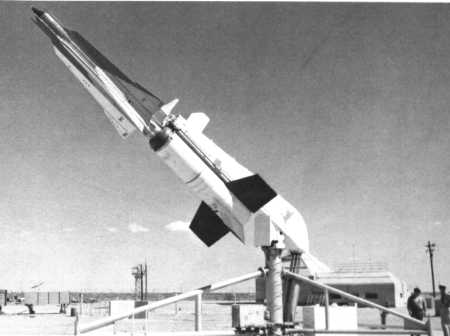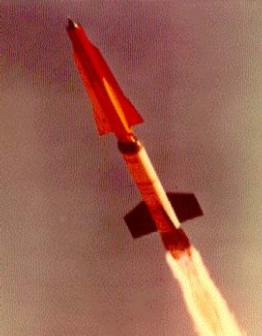Bendix SAM-N-8/RIM-50 Typhon LR
In 1958, it became obvious that the "3-T" series of missile systems (RIM-8 Talos, RIM-2 Terrier, and RIM-24 Tartar) could be easily defeated by mass attacks because of guidance system saturation. Each missile required its own guidance-beam generator and target illuminator, so the maximum number of targets which could be handled simultaneously was inherently limited, and independent of missile rate-of-fire. In 1958, the intended solution to this problem was track-via-missile guidance, in which radar signals were received by the missile, but processed on the surface ship with its much greater computing power. The heart of the new system would be the massive AN/SPG-59 electronically scanned tracking radar, which could track multiple targets and intercept missiles.
The new program was originally called Super Talos/Super Tartar. Because of possible confusion with upgrade programs for Talos and Tartar, the new name of Typhon was soon assigned. Two missiles were to be developed: The long-range SAM-N-8 Typhon LR was to replace Talos, but the missile was planned to be of Terrier size. The medium-range SAM-N-9 Typhon MR was to replace both Terrier and Tartar with a Tartar-sized missile.
The Typhon LR was actually the second vehicle to carry the SAM-N-8 designation, this having been used earlier very briefly for the XSAM-N-8 Zeus gun-launched guided anti-aircraft projectile. However, the Zeus was not a proper missile, and so the designation was cancelled for later re-use.
 |
 | |
| Photo: U.S. Navy | Photo: U.S. Army | |
| SAM-N-8 (RIM-50A) | ||
The first SAM-N-8 prototype was fired in March 1961, and a few more test flights followed. The Typhon would have been a very impressive system, capable of targeting Mach 3 aircraft and missiles, Mach 4 short-range rockets, and small to medium-sized surface ships. Maximum line-of-sight range of the SAM-N-8 was 200 km (110 nm) at 29000 m (95000 ft), and minimum effective range and altitude were 5500 m (6000 yds) and 15 m (50 ft), respectively.
However, the whole Typhon system was very complex and expensive, and in December 1963 the whole Typhon program was cancelled. Instead, the Navy turned to the development of RIM-66/RIM-67 Standard missile family to replace Terrier and Tartar. Shortly before cancellation, the SAM-N-8 Typhon LR had received the designation RIM-50A in the joint missile designation system of 1963.
Specifications
Note: Data given by several sources show slight variations. Figures given below may therefore be inaccurate!
Data for RIM-50A:
| Length (w/o booster) | 4.70 m (15 ft 5 in); booster: 3.70 m (12 ft 2 in) |
| Wingspan | 1.02 m (40 in); booster: 1.57 m (62 in) |
| Diameter | 0.41 m (16 in); booster: 0.47 m (18.5 in) |
| Weight (w/o booster) | 77 kg (1700 lb); booster: 870 kg (1920 lb) |
| Speed | Mach 4.0 |
| Ceiling | 29000 m (95000 ft) |
| Range | 370 km (200 nm) |
| Propulsion |
Solid-fueled rocket booster Bendix ramjet sustainer |
| Warhead | 68 kg (150 lb) HE warhead or W-60 low-yield nuclear warhead |
Main Sources
[1] Norman Friedman: "US Naval Weapons", Conway Maritime Press, 1983
[2] Bill Gunston: "The Illustrated Encyclopedia of Rockets and Missiles", Salamander Books Ltd, 1979
Back to Current Designations Of U.S. Unmanned Military Aerospace Vehicles
Back to Directory of U.S. Military Rockets and Missiles
Last Updated: 30 September 2001